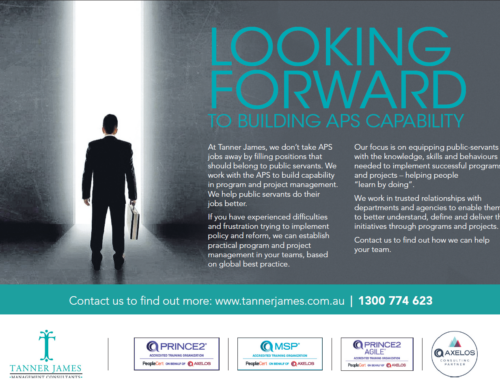Here at Tanner James, I was recently talking to a participant on one of our PRINCE2 training courses – they are working on a nationwide project which involves a complex mix of disciplines including legal, medical, education and training. The leader of this initiative (let’s call her Sharon) has oversight of a project budget of around $10m, with a delivery timeframe of 3 years.
Sharon is a confident leader and convincing speaker. Her project appears to be a blazing success and her immediate superiors regularly praise her efforts.
Unfortunately, the reality is very different – Sharon is disorganised and the project lacks direction. She proudly tells her team “a bite at a time, you make possible what at first seemed impossible” – Sharon uses this statement to justify her leadership style or lack thereof. She only ever thinks about one day or week at a time – with no long term planning or project management anywhere in sight.
This approach allows her to avoid being tied down on any detail. Sharon undermines any attempts by her team to obtain agreement on scope and timing. Consequently, they lurch from one crisis to the next. To cope with this chaos, Sharon works long hours and expects her team to display the same commitment – often pressuring them to work on weekends or to even cut short pre-approved leave to deal with some emergency or another.
This environment, takes a heavy toll on her team. They are often stressed and confused, rarely know what they’ll be working on from one day to the next and rather than being thanked for their efforts, are blamed when things go bad (which, as you might expect is more often than not).
This style of leadership is clearly less than ideal.
But what does good project leadership look like? What are the options available and which one is right for your project?
There are various schools of thought on this, and the truth is that each one has it own pros and cons and will be more or less effective depending on the nature of the project, the culture of the organisation, the size of the team and their level of experience.
Common attributes of good project leadership include: clarity of purpose, the project team feeling inspired and being empowered, stakeholders engaged and actively involved in the journey, timely and transparent decisions, clear accountability, commitment, honesty and passion.
Some styles of project leadership include:
- Autocratic – the leader provides clear direction and control to their project team.
- Consultative – the leader seeks input from stakeholders and project team members before proceeding to make a decision.
- Visionary – the leader is focussed on conveying an overall vision to the project team.
- Transactional – the leader uses positive rewards such as incentives and bonuses to motivate the project team.
- Servant-leadership – the leader becomes a coach and mentor, ensuring everyone in the project team is looked after and has what they need (this was covered in a recent blog post by Tanner James).
- Laissez-Faire – the leader provides broad guidance and the project team work out the details for themselves.
Good leaders will probably merge these styles together – purposefully and seamlessly shifting between them to suit various situations.
Who needs to lead the project? Good leadership should exist at multiple levels. Among others, the Project Executive (sometimes also known as the Project Sponsor), the Project Manager, the Senior User(s) and Senior Supplier(s), Product Owner(s), Scrum Master(s), Team Leader(s), and Change Manager(s) all need to display appropriate leadership qualities.
Regardless of which style is used, one thing is for sure, don’t model yourself on Sharon. Delivering a project “one bite at a time”, without proper planning and management, is sure to end in disaster for the project and the team.






Leave A Comment